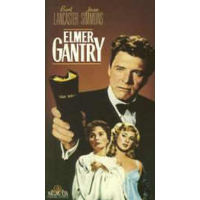Who is the blogger?
Archived entry
Burt Lancaster does some very interesting work in both "Elmer Gantry" (1960) INDb and "The Swimmer" (1968) INDb. Both films prove to be revelatory in both the figurative and the literal sense:) These screen adaptations of literary vehicles might leave you slightly off balance, but still glued to the screen.
Catch the video trailer for "Elmer Gantry"
Startling Revelations
“She’s such a hypocrite!” What a frightful thing to say about someone. How easy it is to say. Worse still, how easy it is to have someone else say it about you!
 This week on TVOntario’s Saturday Night at the Movies we were presented with two films starring Burt Lancaster. The films explored, in one way or another, what happens when the inside does not match the outside of a person. “The Swimmer” is an adaptation from a short story by John Cheever. “Elmer Gantry” is from the Sinclair Lewis novel of the same name. Both films fell into the category of “not easy, but definitely interesting” for me.
This week on TVOntario’s Saturday Night at the Movies we were presented with two films starring Burt Lancaster. The films explored, in one way or another, what happens when the inside does not match the outside of a person. “The Swimmer” is an adaptation from a short story by John Cheever. “Elmer Gantry” is from the Sinclair Lewis novel of the same name. Both films fell into the category of “not easy, but definitely interesting” for me.
One reviewer that I came across had read the original Sinclair Lewis novel, “Elmer Gantry”. He offered some interesting insights on the differences between the film and the original book. The happenings of the movie were apparently lifted from a single chapter of the novel. The titular character as drawn by Lewis was supposed to be a much darker caricature than the Gantry we meet in the film.
Gantry’s larger than life portrait in the film , complete with wide smiles, firm handshakes and lewd jokes, allows for some ambiguity. Richard Brooks wrote the screenplay and directed Burt Lancaster to his Oscar winning performance in the title role. In the novel, Gantry was actually married to Lulu at one time. This leftover from the original novel may help to explain what some find to be Lulu’s otherwise unlikely attachment to Gantry. Apparently the original Gantry was a much shiftier, unrepentant sort of egomaniac. Lancaster ’s Gantry, while an opportunist and a charlatan to the core, leaves room for some kind of human sympathy. Although there are no indicators that he is on the road to redemption by the end of the film, one feels that his adventure with Sister Sharon may have in some way impacted Gantry.
To me at least, it seems that the female evangelist, Sharon Falconer, really believes in what she preaches. She may have been taken in by her own publicity, so to speak, caught up in creating her own “empires in the air”. However, Falconer at least appears to be sincerely deluded at some level. Both the character of Sister Sharon and Jean Simmons, the actress who plays the part, can be rightly described as “luminous”.
 When near the end of the film, just before the big incendiary finish, Sister Sharon undertakes to pray for the healing of a deaf man who unexpectedly comes forward during her revival service, it is unclear whether the “healing” that takes place is genuine or not. We cast about for explanations. Skeptics probably believe it to be another sham, a part of the show like the antics of the monkey or the milk pails during previous tent meetings. Perhaps some hardened modernists like the veteran journalist Jim Lefferts wish to write it off rather hastily - the reversal of some sort of psychosomatic illness that constitutes no true miracle. Those who have it in for Sister Falconer and eagerly await her next misstep will put it down to a case of supreme hubris mixed in with the mass hallucination of a gullible crowd. But then, there is always the possibility that God really and truly performed a miracle. It just might be the case that God permitted Sister Sharon to fulfill her wish to be used as an instrument of divine healing. Take your pick. I think any and all of the explanations could be made to fit the dimensions of the script. It seems to have more to do with the already present belief system of the observer than anything else.
When near the end of the film, just before the big incendiary finish, Sister Sharon undertakes to pray for the healing of a deaf man who unexpectedly comes forward during her revival service, it is unclear whether the “healing” that takes place is genuine or not. We cast about for explanations. Skeptics probably believe it to be another sham, a part of the show like the antics of the monkey or the milk pails during previous tent meetings. Perhaps some hardened modernists like the veteran journalist Jim Lefferts wish to write it off rather hastily - the reversal of some sort of psychosomatic illness that constitutes no true miracle. Those who have it in for Sister Falconer and eagerly await her next misstep will put it down to a case of supreme hubris mixed in with the mass hallucination of a gullible crowd. But then, there is always the possibility that God really and truly performed a miracle. It just might be the case that God permitted Sister Sharon to fulfill her wish to be used as an instrument of divine healing. Take your pick. I think any and all of the explanations could be made to fit the dimensions of the script. It seems to have more to do with the already present belief system of the observer than anything else.
Another scene dealing with doubt that is, shall we say, less flamboyant makes its way into the film. The various church leaders of the town of Zenith get together to organize Sister Sharon’s upcoming campaign. The arguments “for” and “against” having the revival meetings in town are discussed at length. Eventually the “ayes” have it, but not without some reservations being brought forward by some of the brethren. The ringleader of the “for” contingent is the upstanding citizen Babbitt. In reality, Babbitt is a 32nd degree Mason with real estate holdings used for shady purposes and is eventually exposed as a fraud. (Quelle surprise!)
The leader of the “agin it” side is one right Reverend Van Gillam. Van Gillam doubts the validity of the revival meetings. He is preoccupied by other concerns such as building a gym for the teens and seeing that kids have milk to drink. I believe Van Gillam is the one who says that “Religion is not a business and revivalism is not religion!” in response to the arguments given by the worldly-wise Babbitt for the campaign. The reverend is concerned about the longevity of the “conversions” produced by the revivalists’ campaign. An example of such a "conversion" is the janitor sweeping up after a tent meeting. This unfortunate says, “I’ve been converted five times! Things get right terrible (with drinking) and then I get saved. Done me a powerful lot of good!”
Much later onVan Gillam shows up again. This is after all of the ruckus with Gantry’s very public campaign to shut down the houses of ill repute and his spectacular fall from grace thanks to the photojournalistic opportunism of Miss Lulu (Shirley Jones). The crowd has turned hostile against Sister Sharon and Gantry. When Van Gillam is asked why he has come to the tent meeting to face down the bull whip and rotten tomatoes beside Sister Sharon when he has never showed up before, he gives an odd reply: “They’ve never been in trouble before.” Low and behold “Elmer Gantry” does record that such a thing as true Christian charity, unclouded by self interest, does exist somewhere in the world. Surprisingly enough in this session of endless hypocrisy and muckraking, Van Gillam is shown to benothing more and nothing less than a real Christian.
The journalist, Jim Lefferts, shows human sympathy for Gantry after his fall. I rather think though that the Rev. Van Gillam would give a different explanation for his actions, had someone asked him. Beyond human sympathy, I think that Van Gillam would have said that he thought that defending the revivalists was the right thing to do before God. Even though he disagreed with them, he felt it was right to stand by them at the price of his own reputation, as God enabled him.
 Lefferts, an agnostic, complains in print at one point that there is nothing to protect the people from the revivalists. Lefferts goes on a crusade of his own. He alerts the public and attacks in print the person and the credentials of Sister Sharon. However, the Church does not take the view that there is nothing and no one to defend people against false teachers and opportunists. In spite of the new-fangled technology (radio, phone call centres and modern marketing) employed by the revivalists in “Elmer Gantry”, the problem posed by their activities is not a new one. It has been around since the very beginnings of the Church. Pastor Van Gillam in this film apparently does not feel the need to conduct inquisitions or require crucifixions.
Lefferts, an agnostic, complains in print at one point that there is nothing to protect the people from the revivalists. Lefferts goes on a crusade of his own. He alerts the public and attacks in print the person and the credentials of Sister Sharon. However, the Church does not take the view that there is nothing and no one to defend people against false teachers and opportunists. In spite of the new-fangled technology (radio, phone call centres and modern marketing) employed by the revivalists in “Elmer Gantry”, the problem posed by their activities is not a new one. It has been around since the very beginnings of the Church. Pastor Van Gillam in this film apparently does not feel the need to conduct inquisitions or require crucifixions.
Gantry is exposed by less savoury individuals such as Miss Lulu primarily as a result of his own actions. Gantry lives through the disastrous events of the collapse of Sister Sharon’s life and ministry. For me, nothing in the film suggests that Gantry will reform his ways. Elmer Gantry does have a life to live and choices to make, just like anyone else. At least in this town, Gantry has been involved in things that are immoral and unethical but not in the illegal, strictly speaking. No one is going to lock him up. He is as free as a bird to walk away from Zenith and do as he pleases. But is Gantry really free and will he really find what pleases him?
What a terrible fate to lead a double life – to be a glowing advertisement for one thing on the outside and a hollow cavern on the inside. Burt Lancaster pulls it off beautifully in both “Elmer Gantry” and in “The Swimmer”.
 I was really looking forward to watching this little gem, “The Swimmer”, in the summer reruns. I knew I would catch things that I missed the first time around. Roger Ebert describes this film as “a strange, stylized work . . . brilliant and disturbing”. I would agree with the use of all of those adjectives. The literary student in me was delighted by John Cheever’s short story captured on celluloid.
I was really looking forward to watching this little gem, “The Swimmer”, in the summer reruns. I knew I would catch things that I missed the first time around. Roger Ebert describes this film as “a strange, stylized work . . . brilliant and disturbing”. I would agree with the use of all of those adjectives. The literary student in me was delighted by John Cheever’s short story captured on celluloid.
Although the action of this film takes place only forty years after that of “Elmer Gantry”, much has changed in America in the intervening generation. The only reference to things religious is an obscure quote from the Song of Solomon as love poetry. It is an artefact that the young Julie finds “pretty” and “confusing”. The environment of the Connecticut suburbanites, who all seem to have in-ground pools in this neighbourhood, is decidedly secular. The pursuit of materialism, elbowing each other on the ladder of social ascent, an abundance of liquor, and grabbing at one another’s wives on the sly all seem to be the common pastimes of the comfortable upper middle class with whom Neddy Merrill associates.
Things start out pretty well grounded in reality as Merrill, an upscale executive of some sort, comes up with his scheme to swim the “ Lucinda River ”. The idea of swimming across the state through people’s private pools seems a little bit odd to our ears and to the hearing of some of Neddy’s innumerable friends, but no one seems terribly perturbed. Ned is such a charming, affable fellow after all.
 The intrusion of kaleidoscope camera effects and strange dream-like sequences with a galloping horse signal that something is more than a little bit off with someone’s perspective. Merrill is not all that firmly attached to reality after all. He just looks that way. Little by little, holes begin to appear in the smooth surface of Neddy Merrill’s outward presentation. He has problems remembering things; he becomes angry over a hotdog cart; some of the details of his life’s chronology seem a bit screwy to other people.
The intrusion of kaleidoscope camera effects and strange dream-like sequences with a galloping horse signal that something is more than a little bit off with someone’s perspective. Merrill is not all that firmly attached to reality after all. He just looks that way. Little by little, holes begin to appear in the smooth surface of Neddy Merrill’s outward presentation. He has problems remembering things; he becomes angry over a hotdog cart; some of the details of his life’s chronology seem a bit screwy to other people.
Neddy Merrill’s appearance of an enviable existence starts to come unravelled. Although he wears nothing but a bathing suit throughout, it eventually becomes clear that there is lots about his person that we can’t see. Merrill becomes dangerously exposed. The hilarious scene with the Hallorans – the nudist couple where the lady of the house sports only horn rimmed glasses and a modest string of cultured pearls – has Merrill taking off his  bathing suit off camera in deference to household decorum. The scene is very revealing. It is confirmed that other people are au courant of Neddy’s financial difficulties. Neddy himself either can’t or won’t face up to these difficulties. Merrill goes from one experience of being humiliated and exposed to an even more humiliating experience at the public swimming pool. He has to mooch the price of admission from an acquaintance. What kind of self respect if left for Neddy, forced to expose even the skin between his toes to public scrutiny by the local fungus inspector?
bathing suit off camera in deference to household decorum. The scene is very revealing. It is confirmed that other people are au courant of Neddy’s financial difficulties. Neddy himself either can’t or won’t face up to these difficulties. Merrill goes from one experience of being humiliated and exposed to an even more humiliating experience at the public swimming pool. He has to mooch the price of admission from an acquaintance. What kind of self respect if left for Neddy, forced to expose even the skin between his toes to public scrutiny by the local fungus inspector?
 The social rejection that Merrill experiences becomes more intense along the way climaxing with the cruel rejection of his former mistress, Julie Rule (Shirley Abbott). Merrill’s confusion and disorientation from reality is shown to be complete as he finally arrives at his deserted home in the midst of a rainstorm. Merrill cowers helplessly in the doorway, a totally devastated and pathetic figure.
The social rejection that Merrill experiences becomes more intense along the way climaxing with the cruel rejection of his former mistress, Julie Rule (Shirley Abbott). Merrill’s confusion and disorientation from reality is shown to be complete as he finally arrives at his deserted home in the midst of a rainstorm. Merrill cowers helplessly in the doorway, a totally devastated and pathetic figure.
 “The Swimmer” is not a film that gives up its rewards easily to those who are impatient or thick. I found that it was definitely worth waiting for the ending. I thought that Burt Lancaster’s work in both films, although one might be made to feel thrown off balance and slightly uncomfortable, was much to be applauded. This is an actor whose reputation was deservedly built on more than a couple of nice biceps and a few chest hairs.
“The Swimmer” is not a film that gives up its rewards easily to those who are impatient or thick. I found that it was definitely worth waiting for the ending. I thought that Burt Lancaster’s work in both films, although one might be made to feel thrown off balance and slightly uncomfortable, was much to be applauded. This is an actor whose reputation was deservedly built on more than a couple of nice biceps and a few chest hairs.
Things are not always what they seem . People play roles on and off screen. Some people are so caught up in the roles they play that they forget who they really are. Some of us never develop a real identity apart from the role-playing. It can be very difficult to live this way. It can be even more difficult to live with such individuals. It is a very human condition. It makes for a good film drama, of course, but living with the reality of it can be very painful. It’s a good thing to be a good actor. It’s even more of an achievement to be an authentic individual.
Related Reading:
- Lancaster, 55 at the filming of “The Swimmer” and obviously a fine specimen, had a lifelong commitment to physical fitness starting with his first career as a circus acrobat. In spite of his athletic workouts, Burt had emergency quadruple bypass surgery at 70. Go figure!
- Religion is nothing but a pack of problems: "The End of Religion"
- True religion: an oxymoron? (Hit the "expand" button for full context)
- Loved that white robe on Sister Sharon Falconer: on exercising discernment with angelic messengers – How do you know what is and isn’t a false gospel? What about when sincere Christians fall into error?
- A skeptic's quest for authentic religion
- “I struggled with church. . . Shortly after becoming a Christian, I had to commit myself to not placing my faith in the Christians around me in order to not lose my faith.”: Tyrone




Reader Comments